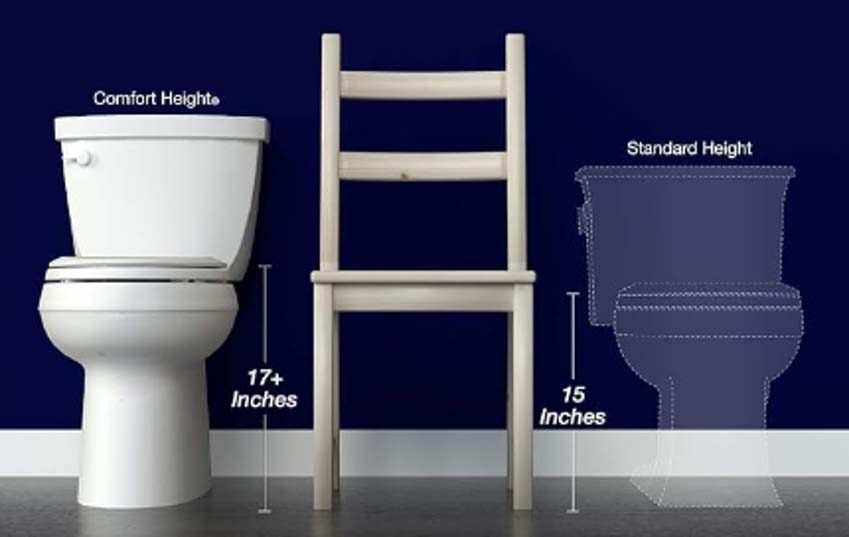
As seniors age, most don’t get the exercise they need to keep their leg muscles strong. Consequently, getting on and off the toilet can be challenging for some seniors. Oftentimes this situation can be rectified by either raising the toilet seat higher or placing a grab bar onto a wall adjacent to the toilet, or a combination of both. A standard toilet is about 14 ½ - 15” high. On the other hand, the height of a kitchen chair is generally around 17-½”+ high. Raising the sitting height of the toilet for better accessibility can be achieved in various ways as follows:
Comfort Height Toilets
The least intrusive option for obtaining a comfortable toilet sitting height without impacting the bathroom’s “ambience” is by replacing the old toilet with a comfort, or chair height toilet. Comfort height toilets range anywhere from 17-½” - 19”. For taller people and those confined to wheelchairs, there are models available in heights of 19 to 22 inches tall and come in many styles, colors and options which blend in with the existing fixtures. However, both taller and comfort height toilets are the most expensive option. We do toilet replacements!
The Toilevator is a riser that is installed under the toilet and adds another 3 ½” to its height. Considering both the labor and materials involved, the Toilevator is probably only a $100 -$150 savings over the installation of a new toilet.
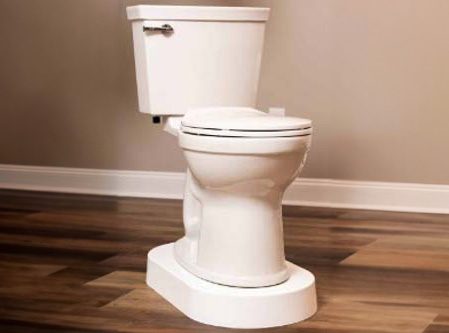
Toilet Seat Risers
The most affordable option to achieving a comfortable seating height on your existing toilet would be to add a toilet seat riser. Risers rest on the rim of the toilet bowl and can raise toilet seats from 2” to 6”. And depending on the model, the riser may or may not be secured to the toilet via either a locking mechanism or bolts. Risers generally work fine for toilet “sitters” since due to their construction, toilet risers provide a much smaller opening for men to target while standing to do their “business”. Risers are generally available for both round and elongated toilet bowls.


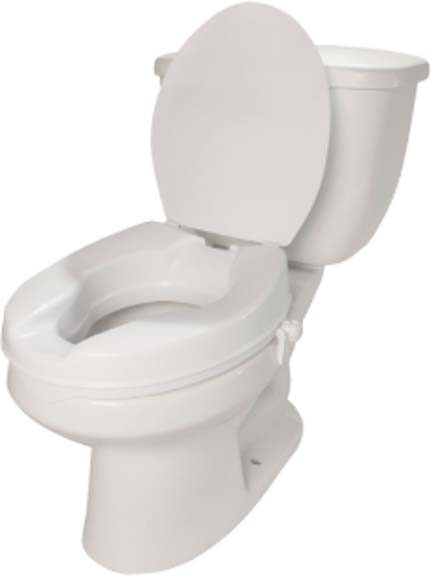
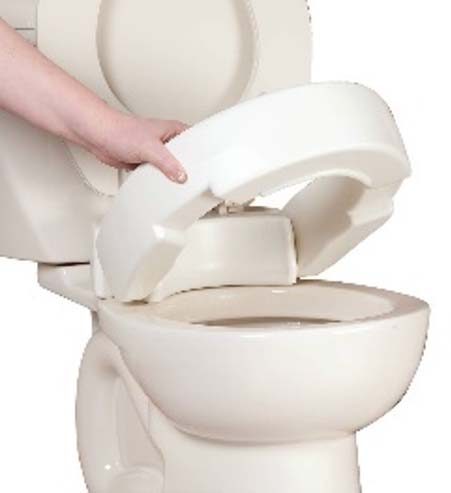
When selecting a toilet riser, some factors to consider include: the height of the riser preferred, the weight capacity (most are 300lbs.), round or elongated, lid cover or not, safety handles or not, fixed or hinged to the toilet and frontal and/or rear hygiene cutouts for easier access when wiping - pics 1 & 3.
Commode Safety Frames
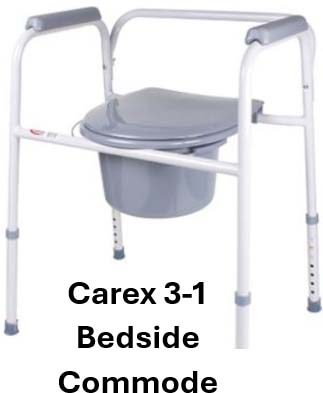
The bedside 3-1 commode chair is a multi-purpose chair that can be transformed to provide the desired need throughout the senior’s recovery progress to greater independence. 1) The chair can serve as a bedside commode when starting rehab at home. It has a removable bucket that captures the waste. (Bucket liners and super absorbent urine odor pads are available to minimize the inconvenience). 2) When the senior is able get to the bathroom independently, the bucket can be removed and the frame, seat & lid can be placed over the toilet at a height comfortable to the senior. 3) The frame can also be a bath chair in larger showers as the footprint of most commode chairs is wider than most tubs. There are other brands like Guardian Padded Drop Arm Commode by Medline that allows the armrest to fold down for wheelchair transport. Moreover, it has a horseshoe style seat that allows for frontal wiping. To view more images online, search for "3+in+1+toilet+commode"
Toilet Height OK - but Still in Need of Help
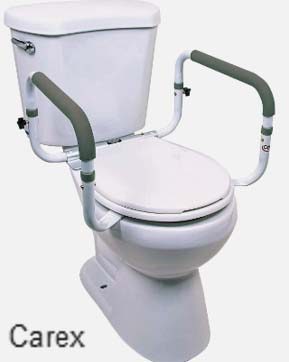
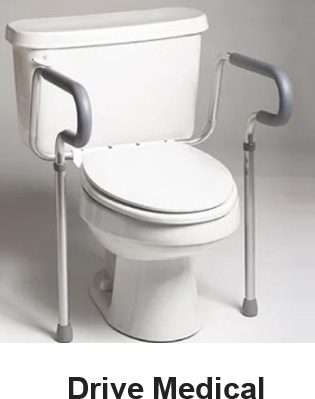
In situations where the toilet height is not a problem but there isn’t a nearby wall for mounting a grab bar, a toilet safety rail frame may be the “ticket” to better accessibility.
Safety rails can be either fixed or free standing. Both are width adjustable and allow for closing the existing toilet lid. Fixed safety frames bolt securely to the toilet and have somewhat limited width expansion capabilities. On the other hand, fixed rails require less bathroom space as shown here with the Carex & Drive Medical toilet safety rails. Most models have a 300 lb. capacity.
Free standing, or stand-alone toilet safety rails are devices that slide over the toilet. The Kmina Safety rail shown here is secured via a bar or strap to the back of the toilet. Free-standing safety rails can provide greater widths than those of mounted rail systems. Some models fold up easily for storage or transporting. Various styles and features can be found online by searching for: toilet+safety+frames. Keep in mind that many walkers can be placed over a toilet to provide accessibility.
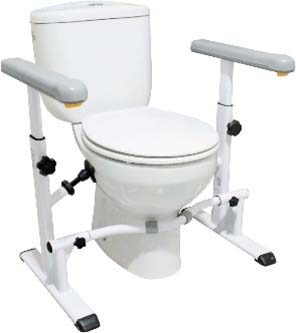
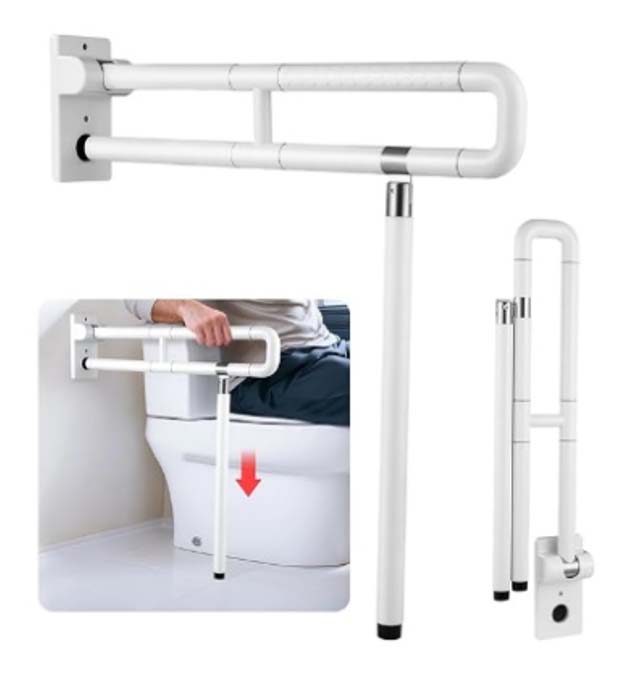
Wall Mounted Foldable Grab Bars – are easily stored, but unless there is blocking (wood support) in the wall, you might want to consider a model with a leg (as shown). Even so, I would only consider going with a leg model only if the person was under 200 pounds and that it could be secure to at least one stud in the wall. Some complaints have been that these bars are wiggly and only extend out 29 inches from the wall. (Made for pushing up rather than pulling oneself off).
Note that for safety handles to be helpful in getting up and off a toilet seat, the senior must have the strength to push up from the safety handle or frame to get off the toilet. Most all the rails discussed previously do not extend beyond the outer rim of the toilet, thus the ability to pull oneself forward is not available. To test as to whether rails aside of the toilet bowl area plausible solution, have the senior’s raise up from a sitting position using a captains’ chair.
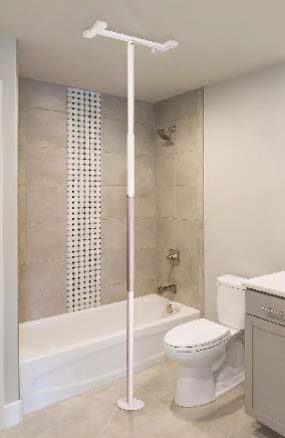
Floor to Ceiling Grab Bars - in bathrooms where the toilet and bathtub are closely adjacent to one another, a Floor to Ceiling Grab Bar (pole) just may be the ticket. Not only could the pole help in toilet accessibility, but in some cases, the pole could be placed to provide the senior safe access for getting into and out of their bathtub as well. Most poles are expandable from 7 to 9 feet via tension springs or screw drives and screwed to both the ceiling and floor permanently. Courtesy Stander Inc.
The foregoing discussion is by no means a complete guide of what aids lie out there for improving your toilet accessibility. Rather, it is intended to help the senior or caregiver make the right selection.
Where to Buy
While internet searches with selective filters can help you home in on a particular riser, I’d like to think that most people would reach out to their neighborhood drug or medical supply store for guidance. There you may get more ideas from the store displays. Beware however, that many medical supply sources, including online suppliers, carry very restrictive or no return policies.
Ohio Walk in Showers & Stairlifts
440-667-8827
OhioWalkinShowers.com
